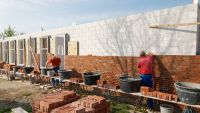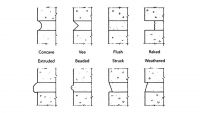New Industry Standard on Calculated Fire Resistance
A joint standard-writing initiative by the American Concrete Institute (ACI) and The Masonry Society (TMS) is coming to a close. The ACI/TMS Committee 216 document, "Standard Method for Determining Fire Resistance of Concrete and Masonry Construction Assemblies" is currently being balloted at the Institute level of ACI's standardization process and is expected to pass as of the ballot's closing date of August 29, 1997. If all goes as anticipated, the standard will have an issue date of 9/1/97 and its availability will be announced in a forthcoming issue of Concrete International. Copies of the standard will be available for purchase in October 1997. ACI's Technical Activities Committee (TAC) has recommended that the standard be published in the 1998 edition of the ACI Manual of Concrete Practice.
Background
The completion of this process marks the end of a 5-year endeavor that became necessary when a Building Officials and Code Administrators, Inc. (BOCA) policy decision prompted the deletion of all non-consensus documents as referenced standards in the BOCA National Building Code (BNBC). This decision left widely recognized code-accepted documents from the past such as ACI-216R "Guide for Determining the Fire Endurance of Concrete Elements," PCI-MNL 124 "Design for Fire Resistance of Precast Prestressed Concrete," CRSI-"Reinforced Concrete Fire Resistance," CMIFCSR267 "Analytical Methods of Determining Fire Endurance of Concrete and Masonry Members--Model Code Approved Procedures" and other industry standards ineligible for referencing in the Code. Two of the major criteria imposed by BOCA on qualifying documents was that they go through a formal consensus process and be written in mandatory language. The last time the aforementioned industry documents were referenced by BOCA's code was in Appendix A of the
1990 edition of the BNBC.
Since BOCA's decision to delete the industry publications was based on policy and not technical content, much of the same material that was previously accepted in the model building codes (BNBC), Standard Building Code (SBC), and Uniform Building Code (UBC) has been included in the new standard. The familiarity of the material is considered an advantage to expediting its approval by BOCA and other model code organizations. BOCA staff has offered to assist industry Code engineers in working with the document for purposes of easing its way through the code process toward acceptance. Timing of the standard's publication is significant in view of the developing First Edition of the International Building Code (IBC) scheduled for release in the year 2000. Plans have been made to propose the new standard for acceptance into the final (1999) issue of the BOCA Code as well as the debut (2000) edition of the IBC.
Contents of the Standard
As mentioned previously, the contents of the standard are not new for the most part. The standard primarily contains prescriptive requirements, but also permits the use of some analytical design procedures. Provisions assume that concrete and masonry elements are designed in accordance with ACI 318 and ACI 530/ASCE 5/TMS 402, respectively, and that the fire exposure is that of the ASTM E119 standard. The standard is not performance-based oriented and is not intended to contain all new state-of-the-art analytical techniques. One of the new changes, however, is the inclusion of an equivalent thickness table for clay brick and tile masonry. The table is shown on the following page.
In the past, fire resistance of clay masonry construction was determined by referring to industry tables that specified ratings of various assemblies with and without finish materials. Presently, with the conclusion of a recent test program sponsored by the Brick Institute of America (BIA), this is no longer necessary. Test data leading to the development of Table 4.1 of the standard now permits the fire resistance of clay masonry assemblies to be calculated using an equivalent thickness technique similar to that of concrete and concrete masonry.
This is seen as a significant improvement over the previous method and lends consistency as to the calculation method used for the three materials. For information purposes, the companion Table 3.1. pertinent to equivalent thickness fire resistance relationships for concrete masonry, remained essentially the same excepting some clarifications made involving aggregate type.
| Material Type | Min. Req. Equivalent Thickness, in. A, B, C for Fire Resistance, hr. | |||
| 1 hr | 2 hr | 3 hr | 4 hr | |
| Solid Brick of clay or shaleD Hollow Brick or tile of clay or shale, unfilled Hollow brick or tile of clay or shale, grouted or filled with materials specified in 4.2.3 | 2.7 | 3.8 | 4.9 | 6.0 |
| 2.3 | 3.4 | 4.3 | 5.0 | |
| 3.0 | 4.4 | 5.5 | 6.6 | |
A Equivalent thickness as determined from section 4.2.
B Calculated fire resistance between the hourly increments listed shall be determined by linear interpolation.
C Where combustible members are framed into the wall, the thickness of solid material between the end of each member and the opposite face of the wall, or between members, shall not be less than 93 percent of the thickness shown.
D For units in which the net cross-sectional area of cored brick in any plane parallel to the surface containing the cores shall be at least 75% of the gross cross-sectional area measured in the same plane.
In closing, I would like to commend the dedicated individuals who volunteered their time to make the standard a reality and to especially acknowledge the efforts of Past Chairman Professor William Gamble, University of Illinois Champaign/Urbana, who went through significant lengths to get this initiative off the ground and headed in the right direction. I feel the standard will serve the industry well in that it was developed with major industry input. This is far superior than being left in a position of having to accept a document developed and forced upon us by others.
About the Author
James P. Hurst, P. E. is the Senior Fire Protection Engineer for the Portland Cement Association and has served as Chairman of ACI/TMS Committee 216 for Fire Resistance and Fire Protection of Structures.


















